Category Archives: All UkulelePlay! Blog Posts
Ukulele Summer Session for Youth & Adults in American Fork, UT
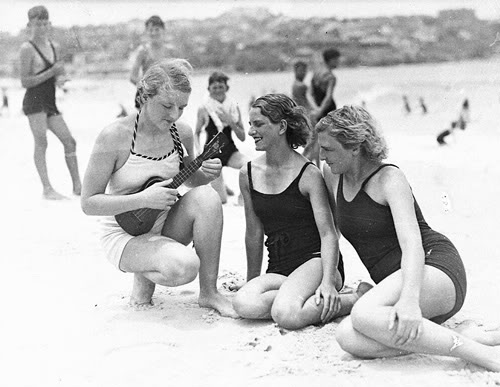
Every two weeks we’ll follow a format similar to Choir!Choir!Choir! – learning one song and then making a video that you can share with family and friends online. Because of this one-rehearsal and then go format, you can expect that there will not be anything too difficult in the Ukulele Summer Session. Non-singers are welcome to strum, fingerpick and tab. Non-players are welcome to come and just sing. If you do both, you’ll be welcome to show off your skills. 🙂
- Dates: Wednesdays, July 8th, July 22nd & August 5th
- Time: 6:30 – 8 pm
- Location: Quail Cove Park, American Fork UT – Across the street from the Mt. Timpanogos Temple. There is plenty of room for social distancing between family groups.
- Suggested Tip: $5 for individuals, $10 for families for each evening (cash, check or paypal) or subscribe at https://www.patreon.com/uke for additional online content.
- Bring your Own: Ukulele, Lawn Chairs, Music Stands, Printed Music for that week, Music Clips (in case of wind).
- Difficulty: There will be easy chords for beginners, inversions for intermediate players, and tabs for intermediate to advanced players. Singing will consist of unison, 2-part and 3-part harmony.
Music for Each Week
- July 8th: The Lion Sleeps Tonight
- July 22nd: Ob-la-di, Ob-la-da
- August 5th: Yellow Submarine
Links to music will be sent out a week before each event. There will be a lead sheet that you’ll need to purchase (less than five dollars) and then additional parts that will be available as free downloads for all participants. Look for the first announcement and links next Wednesday.
IMPORTANT
If you are interested in this series, please subscribe to this list at https://ukuleleplay.us5.list-manage.com/subscribe?u=49abb6089a9cb1eda33db0227&id=22101fb5c8 for the bi-weekly announcements on music.
New ‘Camp Songs’ Tutorials
There are now 12 song tutorials in the 2-Chord Camp Songs Playlist (2 more are added each Tuesday, all Summer long). Here are the newest additions:
Join the Uke & Me newsletter and get a Free ’96 American Spirituals for Ukulele’ eBook

Sign up for my newsletter at https://uke-and-me.ck.page/47b778c0c7 and get a free PDF copy of my newest book, “96 American Spirituals for Ukulele.”
More About the Book
Creating this ebook “96 American Spirituals for Ukulele” has been a labor of love … Ever since I was first introduced to spirituals as a choir member in High School, I have loved them, performed them and later taught them to my students. Some are deeply spiritual, while others carry their own brand of humor. Many were born of hope for a better world in a time filled with oppression and heartbreak. I always let my students know where these songs came from, hoping to inspire people in these difficult times to continue to sing with hope and live a life of love, kindness and faith. Hope you enjoy this resource. Please be sure to check out the accompanying free tutorials I’m producing on my Uke & Me YouTube channel (link in the welcome email). Love, peace, ukulele! ~ Ryan
New ‘American Spirituals for Ukulele’ Tutorials
Full playlist currently contains 14 videos. Here are the new additions:
How to Set Up a Music or Dance Multipurpose Room in Your Home
Today we have a guest post from Derek Cannon on setting up a multipurpose music and/or dance studio in your home. Thank you Derek!
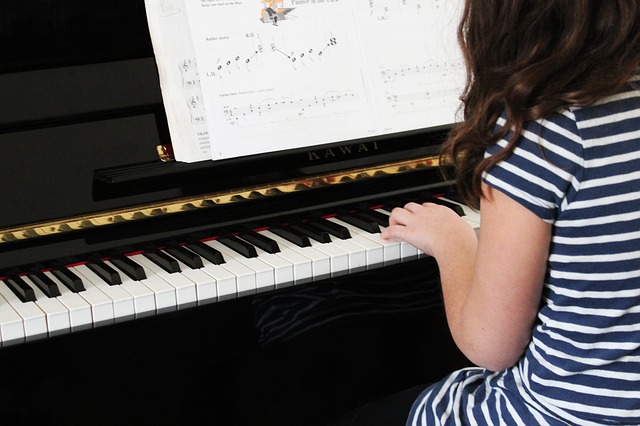
Want to help your tiny dancers and musicians take their skills to the next level? If so, then you should add a multipurpose practice studio to your home! You can set this room up so that your kids can sing, dance, or play an instrument, and you can even use this space to fit some of your needs. In addition to these benefits, a multipurpose space may also add some value to your home. If you’re ready to get started, these resources can help you set up your new studio.
Preparing Your Space
For a room to truly be multipurpose, it needs to be neat and tidy. So, before you bring in any additional items, be sure to deep clean and declutter.
- Get rid of any clutter that is currently taking up space in your spare room.
- Try to be decisive with clutter but know that renting a storage unit is also an option.
- Once you have clutter cleaned out, give your space a nice deep cleaning.
- Use COVID-19 cleaning products while disinfecting too.
Improving Your Space
Honestly, your multipurpose room doesn’t have to be fancy in order to serve as a practice space for music or dance, but there are a few improvements you may want to consider.
- Soundproof your room so that your kids’ practice won’t bother you or your neighbors.
- Wood or laminate floors can provide dancers with a smoother and safer practice.
- Conversely, some carpeting materials can provide better acoustics for musicians.
- To increase the value of your home, opt for prime materials for any studio improvements.
Enhancing Your Kids’ Practice
With your flexible studio all set up, you will want to make sure your kids get the most out of this practice space by utilizing helpful tools and resources.
- Many dance and music sites offer tutorials, videos, and sheet music that can help.
- A mounted TV or monitor can make it easier for kids to follow along with videos.
- Large mirrors mounted on the walls can also help your children practice.
- A high-speed internet connection may come in handy for online videos and apps.
Getting The Most Out of Your Studio
Your studio can be very versatile, especially when you leave the floorplan open and flexible.
- Converting a basement or other large room will provide you with more options.
- A section of your multipurpose room could be used as a home gym.
- Carving out a yoga corner can be a practical choice for smaller spaces.
- It may even be possible to set up a home office in or near your new studio.
There are so many wonderful ways for you to use a multipurpose room in your home! From giving your kids a space to practice their music and dance to providing yourself with a space to exercise and unwind, a multipurpose room can be truly multifaceted. Furthermore, adding a flex room is a great way to boost your home value. So, this really is a smart improvement project!
Photo Credit: Pixabay
Bingo Practice Tracker
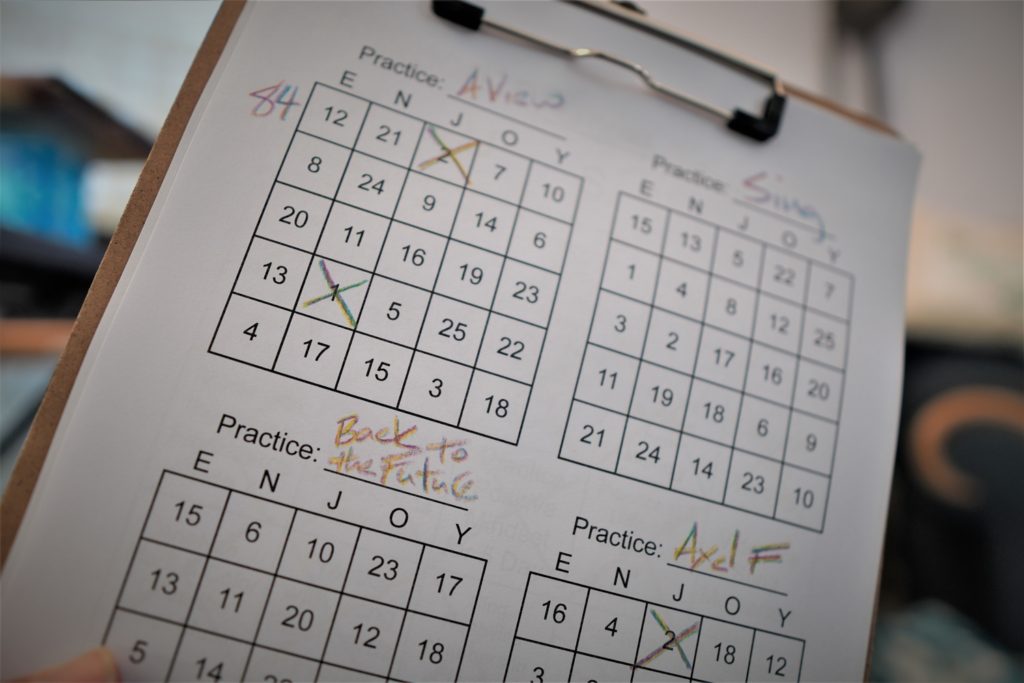
I’m always looking for ways to improve as a player as well as track my progress in my goals. I’ve been using bingo sheets for some time now, and am getting better at working with them. In the beginning, I just had very generic items to cross off in the boxes (piano practice, ukulele, tuba, write in my journal, read a chapter from a book, etc.) … However, I find that you really need to be specific in how you use this kind of tracking or you just end up spinning your wheels and not going anywhere.
So, I’m now using this kind of tracking a little differently, not just to check off that I’ve practiced ukulele, but to track progress on specific songs I’m preparing to record or perform. I’ve created a basic sheet that you can fill in the name of the song and then mark how many times you’ve made it through the song. You could get more specific than this and track different sections or parts of the song (for some of these I’m practicing 3 different ukulele parts, a rhythm part and a bass part). For now, I’ll keep it to complete run-throughs and see how that works.
You can use this system with rewards. I’ve typically put a dollar in a jar for each bingo I complete to spend on something special I’m saving up for … bonus dollars for a blackout. You can set up a reward system differently, or use it without, but it adds an element of fun to it.
Fun Finds: Ukes Not Nukes
In this turbulent time, “All we are saying … is give peace a chance.” Nukes not Ukes T-shirt for anyone promoting the ‘instrument of peace.’ 🙂

Review: Enya Nova Concert Travel Ukulele
Enya Nova Carbon Fiber Ukuleles (Concert Size). Use these links to support content on this blog at no additional cost to you …
- Orange: https://amzn.to/2XVJYLr
- Black: https://amzn.to/36TcFNg
- Blue: https://amzn.to/2AwgJa7
- White: https://amzn.to/301mabV
- Pink: https://amzn.to/2XYxgvu
- Red: https://amzn.to/2KGkmzA
Ukulele Acquisition Syndrome BINGO!
Welcome to UAS BINGO!
If you’ve never heard of Ukulele Acquisition Syndrome (a.k.a. UAS for short)? The Art of the Cell states, “Studies have shown that playing the ukulele dramatically increases the risk of UAS, or Ukulele Acquisition Syndrome. UAS manifests itself in the insatiable need to own ‘just one more’ ukulele.”
May 22nd was #NationalBuyAMusicalInstrumentDay, and being a UAS sufferer, I used it as an excuse to purchase an Enya Nova Concert Travel Ukulele that had intrigued me for some time (I love it – see the review on my YouTube channel).
Got the Disease? Play the Game!
Get your own, randomized Ukulele Acquisition Syndrome Bingo Card at https://bit.ly/UASBingo to play! It will look something like this:
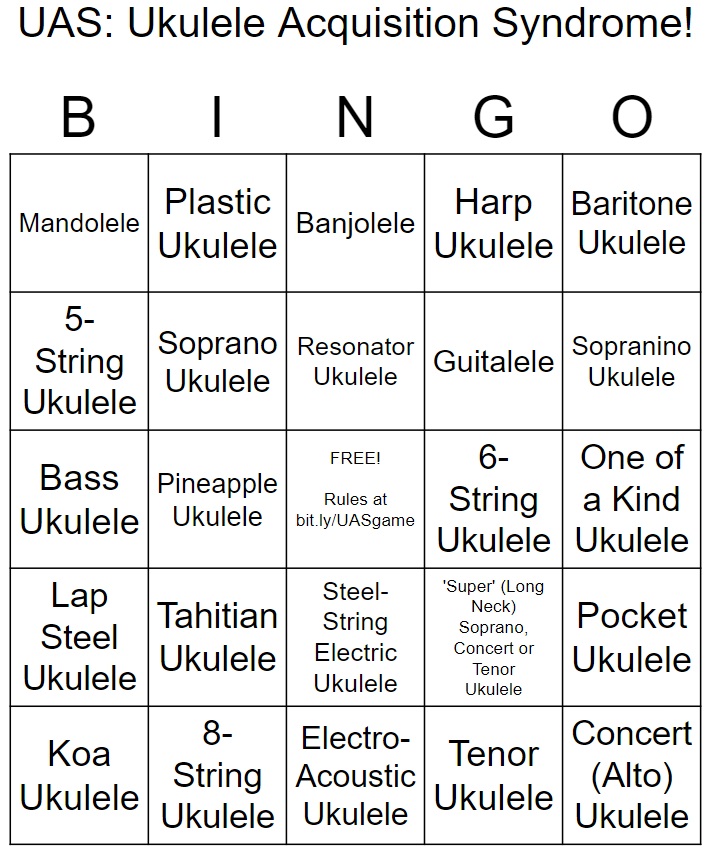
Get a BINGO, Get a Prize
Send the following to ryan@ukuleleplay.com anytime before September 1st, 2020 …
- A screenshot of your bingo card with a completed row, column or diagonal five-in-a-row.
- A photo of the four (if you used the center ‘free’ space) or five ukuleles mentioned on your card.
- Info including your name, location and which book you’d like as a prize. Choose any of the books on this page and I’ll send you a PDF.
I’ll feature your name, location and photo here on the UkulelePlay.com blog.
BLACKOUT!?!?!?
The very first blackout entry I receive will win access to the online course https://bulletproofmusician.com/ that I have reserved for a winner.
How to Share Copyrighted Songs Legally

Disclaimer: I’m not a lawyer; consult a lawyer if you want legal advice.
There are so many websites out there freely sharing lyrics, chords, and tabs to copyrighted material that it seems almost pointless to make a stand. Yet, in the midst of such an abundance of lawlessness, I feel I need to say something to justify why I try not to break the law.
If a song was published after 1922, it is likely that someone owns the rights to that song (songwriter rights and publisher rights). Maybe most people don’t realize that sharing music requires rights, even for educational purposes (except in the case of small snippets), and especially in the case of a number of popular Patreon creators that are sharing that material to gain a subscription following (i.e. for profit). I feel like it is stealing to share something that is not yours to share. This includes:
- Sharing song sheets with just lyrics & chords. Lyrics are half of a songwriter’s copyright.
- Sharing staff notation or tablature that includes the melody of a song. Melodies are the other half of the songwriter’s copyright.
However … If you want to share a song that doesn’t belong to you, there are ways you can do it that do not break the law. As I understand things, here are some ways you may be able to proceed without getting yourself into hot water or wading through ethically grey water (the point is, stay dry) …
- Contact the copyright holder and get permission to share the song. This is difficult and impractical most of the time. Forgive me if I don’t elaborate, but just imagine contacting Disney corporate and seeing if you can get the rights to publish a version of You Ain’t Never Had a Friend Like Me … Let’s just say we’re talking about the stuff of nightmares.
- Work through a program that licenses the rights of songs for publishing arrangements legally, like the Sheet Music Plus SMPPress Program. The catalog of songs that you can legally arrange is absolutely enormous, 1.7 million songs at present (though there are some glaring omissions, like most of the Disney catalog … just don’t do Disney, even if you’re dying to – like me, I love those golden era tunes).
- Publish “In the Style Of” lead sheets. These must not include melody notation or lyrics … people will have to memorize that part (and it is probably good for them to just listen to the song enough times to have it memorized anyway). Chord progressions, rhythms, strumming and even bass lines are not subject to copyright (watch out for signature ‘licks’ though, which could be viewed as melodic material).
- Publish your tutorials via YouTube and hope for the best; they’re currently suggest contacting a lawyer if you want to use someone else’s music, but my experience has been that most publishers will automatically flag your video on copyright grounds for a portion of your revenue share rather than have it taken down or blocked. Still there is the possibility of getting a copyright strike and having your channel removed … most of the publishers just want the revenue though. You can check to see if someone else has ‘covered’ the song you want to do, which may give you an indication if you’ll have trouble, but what’s up today may at any moment be taken down at the whim of the copyright holder. If you want to share a PDF to accompany the video, publish it through SMPPress and add a link to it in the video description.
- No arranging skills? Buy a copy of the music. Ask your club members to buy copies as well. You can get most songs this way. Just Google ‘SONG NAME Sheet Music’ and you’ll probably get several ads for legal copies of the music. Disney songs anyone?
I’ve given this dilemma quite a bit of thought, as it impacts me more as an ukulele teacher than it does as a composer and ukulele artist. People want to learn popular songs, and I don’t blame them. When you’re dealing with large groups of people and preparing full programs of music to perform, the cost of buying copies can really add up. I’ve made some missteps in the past, but am trying to do better.
My Creative Plans for Future Arrangements
- Publish a simple lead sheet with melody, lyrics and chords on SMPPress and set the price as low as they will let me (this means I will make somewhere between 20-40 cents when a copy is sold – not doing it for the money).
- Offer harmonies, countermelodies, bass lines, strumming instructions, fingerpicking, etc. free to my students, ensemble members, and Patrons at patreon.com/uke (i.e. my own original material and the parts of the song that cannot be copyrighted – chords, bass, harmonizations).
Where does this leave me with the Disney conundrum? My group can buy their own copies of a songbook and then I can write out some bass lines, counter tunes and harmonies for them. Problem solved.
Sit Down Servant & Sinner Man – 2 New Episodes from 96 American Spirituals for Ukulele
Sit Down Servant
Sinner Man
Join me at Patreon.com/Uke for PDFs and many more tutorials, articles, tips & tricks for better ukulele playing.
National Buy a Musical Instrument Day : Enya Carbon Fiber Ukulele
Today is #NationalBuyAMusicalInstrumentDay (yes, it really exists). What better excuse for someone with UAS (ukulele acquisition syndrome) to expand his collection by one. I’ve been curious about the Enya Carbon Fiber Ukuleles for some time; the reviews on Amazon are through the roof and they only price out currently at 89.99 … So, I made the plunge and put down my dollars. It should come next Thursday, so expect a review in the next couple of weeks. 🙂
Introducing #TwoChordTuesday with the Launch of “Two Chord Camp Songs for Ukulele” Tutorials
Starting today, and each Tuesday (until I run out of material), I’ll be posting TWO new two-chord song tutorials each week. To begin with, over the next 15 weeks I’ll be sharing tutorials for each of the songs in my book “Two Chord Camp Songs for Ukulele.” Today I’ll also be sharing a bonus introductory video aimed at absolute beginners that covers how to make the chords and other ukulele basics.
Introduction
I’m currently producing content for #TwoChordTuesday, #SundaySongbook, and have other projects in the works for #MusicMonday, #WisdomWednesday, #ThrowbackThursday, #FridayFunday, and #SongwritingSaturday. Please consider joining me over at Patreon.com/Uke and supporting these projects. Patrons get access to PDFs for each of the videos I release.
A Ram Sam Sam
An Austrian Went Yodeling
Felt Ukulele & Crab Plushies
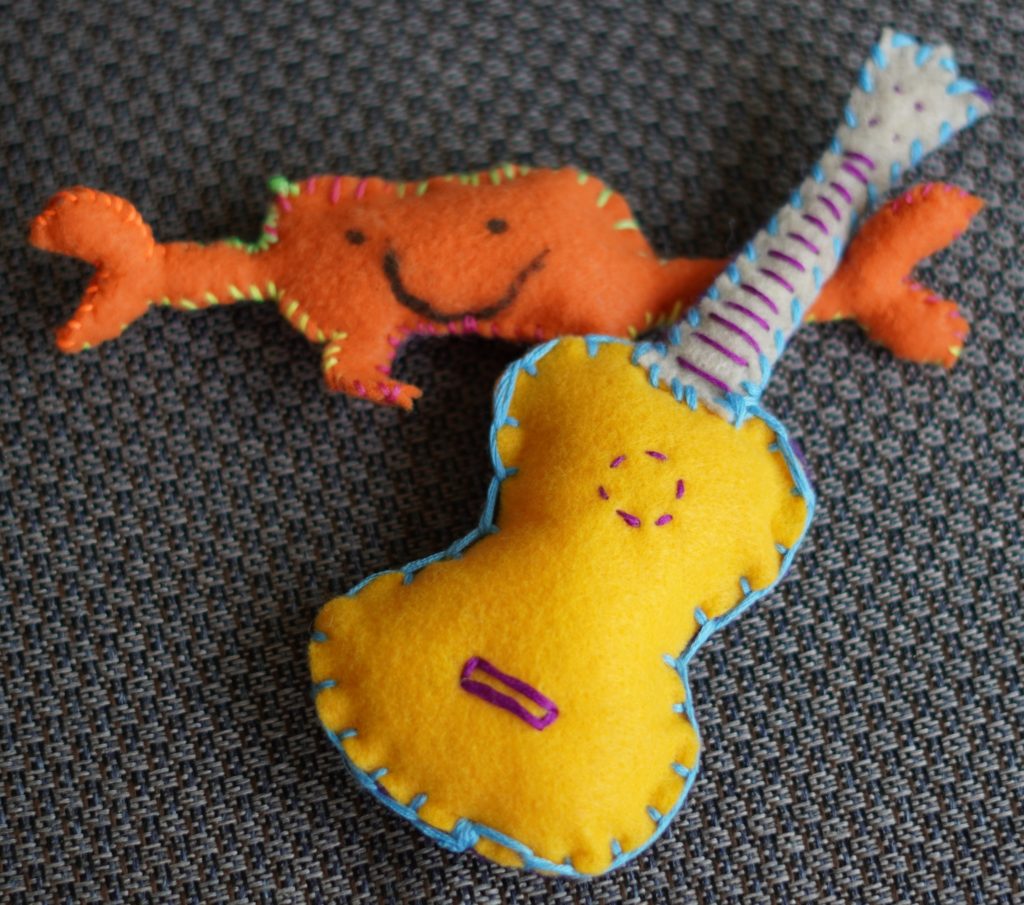
Today my family was making some plushies to give away … Taavi, my six-year-old son, designed a crab that my wife Dixie blew up into a pattern and they both worked on to stitch together. I, of course, made a ukulele. Taavi fell in love with it and took it for a pillow for one of his favorite stuffed animals, so I guess it won’t be traveling anywhere like I’d planned. The crab is still going to one of Taavi’s favorite friends.
Virtual Utah Uke Fest – Call for Entries & Open Mic Submissions
The 9th Annual Original Utah Uke Fest on June 20th, 2020 will be held VIRTUALLY, due to circumstances on a global and local level beyond our control.
What will our virtual festival look like?
- The festival will be prerecorded and uploaded to YouTube as a premiere, so people can watch and make comments in real-time as the video progresses. People will also be able to watch a replay at their convenience.
What will the segments be?
- Classes on any topic related to the ukulele. These could include obscure topics like nail care for ukulele playing, how to make a ukulele strap or case, or more mainstream topics like how to play a song, or how to do a particular strum.
- Open mic entries and performances.
NOTE: As this is a Utah-based, community-building event, we will only accept submissions from UTAH RESIDENTS.
How can I participate as a teacher?
- Send the topic you’d like to teach as an idea to ryan@ukuleleplay.com before MONDAY, MAY 18th.
- Once you have the ‘go ahead’ – film your class using whatever you have available (phone, laptop, camera, etc.), or make an appointment to come and film at Ryan’s home studio if you don’t have anything to record with on your own.
- Upload your video to a file sharing service (Dropbox, Google Drive, etc.) and send a download link to ryan@ukuleleplay.com by June 1st.
How can I submit a performance for the open mic?
- Upload a video of your performance (online collaborations, family numbers, quarantine duets/trios, etc. encouraged) to a file sharing service (Dropbox, Google Drive, etc.) and send a download link to ryan@ukuleleplay.com by June 1st.
When will the Festival Premiere?
- The festival will premiere on YouTube on Saturday, June 20th at 10am and last as long as it ends up being.
- A link to the premiere will be shared on UtahUkeFest.org as well as the festival Facebook page and through our email list (email ryan@ukuleleplay.com if you want to be on the email list).
How to Ruin Your Multi-Track Video (Epic Fail)
I’ve been wanting to make one of those multi-track videos for some time, but have been a bit nervous about the process, video-editing, etc.. Well, yesterday I pushed through my fears and made myself sit down to record all the parts for one of the songs I’ve been working on with one of my groups for our Back to the 80s set. I plugged my ukulele directly into the sound card (so as not to worry about other noises in the house – everyone’s home right now, all the time), set my metronome to 100 bpm, set up my video camera and started recording.
When I got to the video editing, I found I was having trouble getting the tracks to sync … I’d coordinate the first beat of a section, but then the music would drift apart, as if I were playing at two slightly different tempos. I thought to myself, “Is my timing really that bad?” It wasn’t until I was trying to sync up the last of the videos, a considerably longer one, that I finally clued into what was happening. The beginning was perfectly synced, but a minute later, the track was almost half a beat off. I WAS PLAYING AT SLIGHTLY DIFFERENT TEMPOS BECAUSE …
I had chosen to use my favorite WIND-UP metronome! As the metronome wound down, the tempo gradually got just a minuscule amount slower. For practice, this would not really matter so much, but for syncing digital content it spelled disaster. How much time was wasted in this effort? About 6 hours! Sigh.
Moral of the story: Next time I’ll try using a digital metronome or click track in my recording software.
Don’t Lift a Finger : Chord Voicings in the Key of F
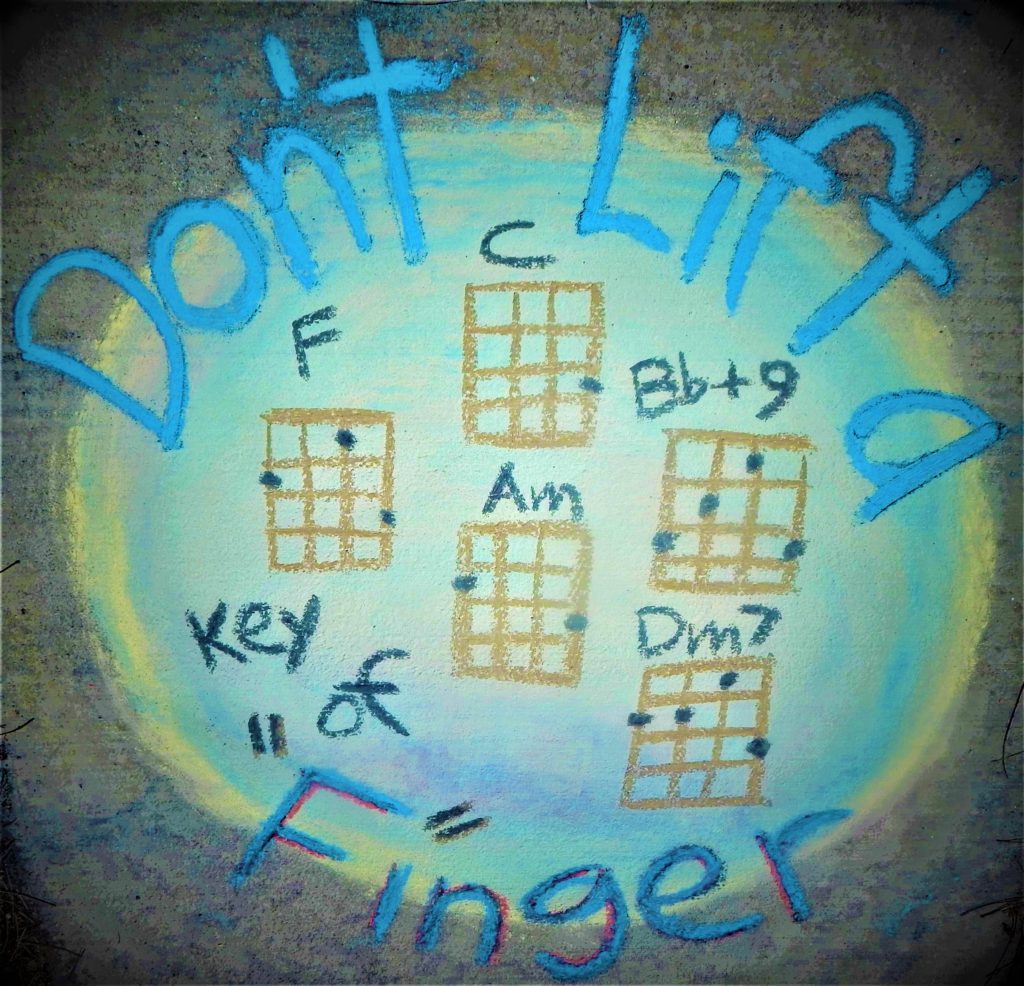
The “Don’t Lift a Finger Set” of chords for ukulele, featuring F, Bb+9, C, Am & Dm7 … the pinky-finger stays on the 3rd fret of the 1st string for all these chords. I was first introduced to three of these chord voicings in an article by James Hill in Ukulele Magazine some years ago. Later, I realized you could easily add Am & Dm7 to the list. What’s cool about this set is that it will work well for many songs in the Key of F without having to use the root fingering for Bb, which barres right next to the nut, making it a frustration for new players and tiresome (depending on your ukulele’s action setup) for seasoned players as well. Once you get used to the transitions, the don’t-lift-a-finger set makes for really quick chord changes in a key a lot of players avoid, even though it’s a GREAT key to sing in.
Ukulele Questions: How do you deal with really sore finger tips?
I was recently asked this question on social media in response to my new video on avoiding chord overwhelm. It’s one that I’ve heard many times before.
Sore fingertips is a problem that faces all players at one point or another. I don’t get sore fingertips anymore (unless I’m playing for 3-4 hours straight) because the calluses on my fingertips are so thick I can poke them with a pin and barely feel it. Calluses do build up over time if you play daily, even just a 10-15 minutes a day. The body is really good at repairing itself, so only daily practice will build the calluses.
I wish there was another solution, one that doesn’t involve building up pads on your fingertips, but as far as I know, that is just what it takes …
HOWEVER, If you’re desperate on this issue, you might consider trying one of the many marketed products that address it, but reviews are mixed on fingertip protectors and there will definitely be some trade offs for wearing silicone fingertip protectors or some kind of guitarist glove … For some people facing issues of neuropathy, or other medical issues, these may be the only way to keep playing. At least they’re worth a try. :-/
Top 5 Tips to Avoid Chord Overwhelm
Top 5 Tips to Avoid Chord Overwhelm …
Chords, chords, chords, chords, chords! The wide world of musical chords can be an overwhelming place. The way people generally learn chords, and how to use them, is often haphazard because the subject is just so vast. Here are my top five tips for diving right in and avoiding being overwhelmed by your study of chords. Let’s get going!
Tip #1 Don’t Assume You Have to Understand Chords Before You Can Use Them or that You Need a Lot of Chords to Make Music … You don’t have to understand how to build a car to enjoy driving, and you don’t have to understand what C7sus4add9 means to be able to enjoy playing it. It’s been famously said that all you need to make music is “three chords and the truth.” There are millions of songs that fit that description out there and I’ve personally collected a large number of folk, camp, Christmas and children’s tunes for my students that can be played with just two chords each.
Tip #2 Just Because a Chord has a Long, Complicated-Looking Name Does NOT Mean it is Hard to Play … On the ukulele, the Fadd9 chord only requires one finger to play, whereas a standard F chord requires two. The C, C7 and Cmaj7 chords each require just one finger to fret. Another one-finger chord with an intimidating name is Gm7b5 which I’ve often used to teach beginners to play Amazing Grace on their very first day. Don’t let the ‘taxonomic nomenclature’ of chords intimidate you. Dive in.
Tip #3 Be Reassured by Your Limits (You Only Have So Many Fingers) … On fretted instruments, you’re generally going to be using just 4-fingers to fret with, while your other hand’s fingers are busy plucking or strumming the strings. While keyboard players can use all ten fingers to play a chord, usually the right hand shoulders the bulk of the chord work, while the left plays supporting bass lines. Knowing your body and your instrument’s limits can actually be reassuring. On a ukulele, mandolin, tenor guitar, etc., you’re never going to be playing more than 4-notes at a time and that number only goes up to 6-notes on a guitar.
Tip #4 Focus on the Songs You Want to Learn … Surely there are songs out there that you love and adore. Make a short list of some songs that you’re really excited about, choose one of these and use the love you have for that song to motivate you to learn the chords you need to sing and play it. If your music doesn’t include chord diagrams, the internet has many sites where you can look up chords. I’ll post some links in the description. One of the best ways to build up your chord vocabulary is one song at a time.
Tip #5 Be Patient with Difficult Chords and Practice Them in Pairs … I’ve observed that the tendency of most players when tackling a new chord is to give it a minute or two and then immediately try to stick it into the context of a song they are trying to learn. This is stressful and unproductive. Isolate that new chord and make sure you can finger it correctly. Once you feel comfortable with the fingering, identify the chord that comes before it in the song and then put those two chords together in a loop, practicing the transition over and over until it becomes smooth … so automatic that you no longer have to think about it. Next, loop the new chord with the chord that comes after it in the song in the same way. By practicing chords in pairs like this, you’re hard-wiring the transitions into your motor memory so you won’t have to worry about it when it comes up in the song. If you give this enough time (while you’re listening to your favorite podcast, or watching your favorite show), you’ll find your transition is much smoother when you put the chord back into the context of the song. Trust me on this one; you’ll be surprised at how effective practicing chords in pairs can be.
_______
If you found this useful, don’t forget to like and subscribe. The best way to get updates on new tips, tutorials and free sheet music is to join me at patreon.com/uke
Don’t forget to comment if you have tips for others that have helped you with chords … you never know who might be helped by hearing about your experience.
Part 2 of this video series on chords will dive into demystifying how chords are built and how to explore the sea of chords without drowning.
Question on Fingerpicking for Ukulele Chords with Doubled Notes
A question from one of my local ukulele friends:
I am teaching my grand-kids ukulele. I taught them the arpeggios – adding a C on chords, such as F. They wanted to play Hallelujah and we played it. Easy enough but I was thinking that plucking the arpeggios would be nice. How do you suggest making Em chords work as an arpeggio?
Anytime you have a note that is doubled in the same octave on an ukulele chord, you can use one of the variations of what some call ‘3-string technique’ … essentially, you just pretend you only have 3-strings for a while and experiment with fingerpicking patterns. A few of the almost limitless possibilities for Em in 4/4 include:
32132132
12 3 12 3 12 3 12 3 (where the twelves are a double-stop)
12312312
43134313 or 23132313 (identical)
You sort of just have to play with it until you find what you’re looking for. Hope that helps!
Kingsfold (If You Could Hie to Kolob) : Ukulele Tablature Solo
Free TAB available at https://www.facebook.com/groups/77615… in the files section. Support this project at http://patreon.com/uke and find more ukulele songs, materials, tutorials, reviews and tabs at http://ukuleleplay.com
That Easter Morn : Ukulele Tablature Solo
Free TAB available at https://www.facebook.com/groups/77615… in the files section. Support this project at http://patreon.com/uke and find more ukulele songs, materials, tutorials, reviews and tabs at http://ukuleleplay.com
